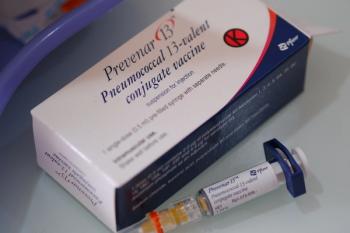
Reevaluating the Use of Guaifenesin in the Management of Acute Cough Associated With the Common Cold
Despite its popularity and its status as an FDA-approved expectorant, evidence to support guaifenesin’s efficacy is limited and conflicting.
Cough is the most common symptom prompting patients to seek health care in the ambulatory care setting. Although a cough can be secondary to a variety of medical conditions, the most common etiology is a viral upper respiratory infection (URI).1 A nonprescription drug commonly used to manage a cough is guaifenesin which is labeled for use as an expectorant. According to a 2019 survey of pharmacists, Mucinex and Robitussin, 2 branded formulations of guaifenesin, were recommended close to 2.5 million times per month during that year.2
Guaifenesin’s use as a medicinal substance dates back to as early as the 1500s when Native Americans used an extract of the guaiac tree as a natural remedy for various ailments.Today, guaifenesin is an FDA-approved drug that is sold in a variety of oral formulations, including liquid dosage forms as well as immediate- and extended-release solid dosage forms. The recommended adult dose of guaifenesin is 200 mg to 400 mg every 4 to 6 hours, as needed, for the immediate-release formulations and 600 mg to 1200 mg every 12 hours, as needed, for the extended-release formulations. Although guaifenesin’s mechanism of action is not fully understood, it is thought to act by irritating the gastric mucosa and stimulating respiratory tract secretions. This, in turn, increases the volume and decreases the viscosity of bronchial secretions.3 In addition to being an expectorant, guaifenesin has also been proposed to act as an antitussive by inhibiting cough-reflex sensitivity in patients with URI.4 Guaifenesin is generally well tolerated with the most commonly reported adverse effects being nausea, vomiting, and gastrointestinal discomfort.4
Despite its popularity and its status as an FDA-approved expectorant, evidence to support guaifenesin’s efficacy is limited and conflicting. The purpose of this article is to present the reader with data from clinical trials which were designed primarily to evaluate the use of guaifenesin in the management of cough associated with URI.
Clinical Data
In 1977, Robinson et al. described a double-blind trial that examined whether guaifenesin was superior to placebo in facilitating the coughing up of sputum and ameliorating dry cough in patients with an acute URI.5 Two hundred and thirty-nine adult patients with moderate-to-severe cough were randomly assigned to receive 200 mg of guaifenesin syrup or placebo 4 times per day for 3 days. Efficacy was evaluated subjectively through patients’ assessments of symptoms and of the quality and quantity of sputum as well as through physicians’ assessments of patients’ symptoms at different time points throughout the study. The investigators reported that, overall, in patients with dry or productive cough, guaifenesin decreased cough frequency, cough intensity, and chest discomfort, and resulted in a significantly thinner sputum. Likewise, in patients with productive cough, guaifenesin was found to facilitate raising sputum. Notably, these findings were not consistent across all the assessment parameters and time points at which they were measured.
In 1982, Kuhn et al. described a double-blind study that evaluated the effect of guaifenesin on cough frequency in young adults with a cough secondary to a cold.6 Sixty-five patients were randomly assigned to receive 400 mg of guaifenesin syrup or placebo every 6 hours for a total of 6 doses. Guaifenesin’s efficacy was evaluated subjectively through a completion of a patient self-assessment questionnaire throughout the course of the study and objectively through a cough count using an audio recording of the patients (performed on 42 of the study participants). The investigators reported that in the subjective evaluation, guaifenesin was associated with a statistically significant decrease in sputum thickness in patients who experienced a productive cough; however, guaifenesin failed to significantly reduce the number of coughs when assessed by objective cough counts.
In 2003, Dicpinigaitis and Gayle described a randomized, double-blind trial that evaluated guaifenesin’s effect on cough reflex sensitivity in 14 healthy volunteers and 14 patients with acute viral URI.7 On 2 separate days, each participant received a 400-mg guaifenesin capsule or placebo. A capsaicin cough challenge test, which involves the inhalation of capsaicin, a known tussive agent, was performed 1 to 2 hours after the ingestion of guaifenesin or placebo. Guaifenesin’s efficacy was determined by the concentration of capsaicin needed to induce 5 or more coughs (C5). The investigators reported that in the participants with URI, mean log C5 afterguaifenesin was significantly higher than after placebo; in the healthy volunteers, such a difference was notnoted. The investigators concluded that a single, 400-mg dose of guaifenesin inhibits cough reflex sensitivity to inhaled capsaicin in individuals with acute viral URI.
In 2009, Dicpinigaitis et al. described a study that assessed the antitussive effect of guaifenesin and benzonatate, alone and in combination, in 30 adult patients with acute URI.8 In this double-blind, placebo-controlled, crossover study, patients were randomized to receive capsules containing benzonatate 200 mg, guaifenesin 600 mg, benzonatate 200 mg plus guaifenesin 600 mg, or placebo. Patients received a single dose of 3 of the 4 aforementioned treatments on 3 separate days within a 7-day period. The study utilized the capsaicin cough challenge and its main efficacy measure was C5. The investigators reported that mean log C5 was significantly greater with guaifenesin as compared with placebo; mean log C5 with benzonatate plus guaifenesin was also significantly greater than with guaifenesin alone. The authors noted that guaifenesin and the combination of guaifenesin and benzonatate inhibited cough-reflex sensitivity in patients with acute URI.
In 2014, Hoffer-Schaefer et al. described a study that evaluated the impact of guaifenesin on sputum properties associated with a productive cough secondary to an acute URI.9 In this double-blind, placebo-controlled, multicenter study, 378 adolescent and adult patients were randomized to receive 1200 mg of extended-release guaifenesin or placebo every 12 hours for 7 days. No significant differences were found in the any of the sputum measures in the guaifenesin group as compared with the placebo group.
In 2015, Bennett et al. described a study assessing the effect of guaifenesin on mucociliary clearance and cough clearance as measured by the rate of removal of inhaled radioactive tracer particles; other sputum properties were also assessed.10 Participants were also asked to subjectively rate the severity of the chest congestion, mucus thickness, and cough. In this double-blind, placebo-controlled study, 38 adult patients with acute URI were randomized to receive a single 1200-mg dose of extended release guaifenesin or placebo. Assessments were conducted at several time points over the course of the post-dose period. Guaifenesin use did not result in significant improvements in any of the objective outcome measures as compared with placebo. A statistically significant difference favoring guaifenesin was noted in the subjective assessment of mucus thickness at one of the evaluation time points.
Summary
Few clinical trials have been conducted to assess guaifenesin’s efficacy in the management of cough secondary to URI. The trials varied in their methodologies (eg, dosage forms, dosage regimens, outcome measures) and generally included a small number of participants. In these trials, guaifenesin was found to be effective in some, but not all, of the assessments of efficacy. Given these mixed results, drawing firm conclusions about guaifenesin’s efficacy is challenging. Nonetheless, given its overall safety profile, the use of guaifenesin may be considered on a case-by-case basis for patients who are bothered greatly by their cough.
Dr Nathan is the director at the International Drug Information Center and associate professor at Arnold & Marie Schwartz College of Pharmacy and Health Sciences, Long Island University.
Dr Grossman is a drug information specialist at the International Drug Information Center and adjunct assistant professor at Arnold & Marie Schwartz College of Pharmacy and Health Sciences, Long Island University.
References
1. Frei CR, Frei BL. Upper Respiratory Tract Infections. In: DiPiro JT, Yee GC, Posey L, Haines ST, Nolin TD, Ellingrod V, eds. Pharmacotherapy: A Pathophysiologic Approach, 11e. McGraw-Hill; Accessed August 27, 2020.
2. Contemporary Clinic. Pharmacy Recommendations.
3. Albrecht HH, Dicpinigaitis PV, Guenin EP. Role of guaifenesin in the management of chronic bronchitis and upper respiratory tract infections. Multidiscip Respir Med. 2017;12:31. Published 2017 Dec 11. doi:10.1186/s40248-017-0113-4.
4. Guaifenesin. In: IBM Micromedex® DRUGDEX® (electronic version). IBM Watson Health, Greenwood Village, Colorado, USA. Accessed August 27, 2020.
5. Robinson RE, Cummings WB, Deffenbaugh ER. Effectiveness of guaifenesin as an expectorant: a cooperative double-blind study. Curr Ther Res.1977;22(2):284-296.
6. Kuhn JJ, Hendley O, Adams KF, Clark JW, Gwaltney JM. Antitussive effects of guaifenesin in young adults with natural colds. Chest.1982;8(6):713-718.
7. Dicpinigaitis PV, Gayle YE. Effect of guaifenesin on cough reflex sensitivity. Chest. 2003;124(6):2178–2181
8. Dicpinigaitis PV, Gayle YE, Solomon G, Gilbert RD. Inhibition of cough-reflex sensitivity by benzonatate and guaifenesin in acute viral cough. Respir Med. 2009;103(6):902-906. doi:10.1016/j.rmed.2008.12.008.
9. Hoffer-Schaefer A, Rozycki HJ, Yopp MA, Rubin BK. Guaifenesin has no effect on sputum volume or sputum properties in adolescents and adults with acute respiratory tract infections. Respir Care. 2014;59(5):631-636. doi: 10.4187/respcare.02640.
10. Bennett WD, Kala A, Duckworth H, et al. Effect of a single 1200 mg dose of Mucinex on mucociliary and cough clearance during an acute respiratory tract infection. Respir Med. 2015;109(11):1476-1483. doi: 10.1016/j.rmed.2015.09.017.
Newsletter
Pharmacy practice is always changing. Stay ahead of the curve with the Drug Topics newsletter and get the latest drug information, industry trends, and patient care tips.




























































































































